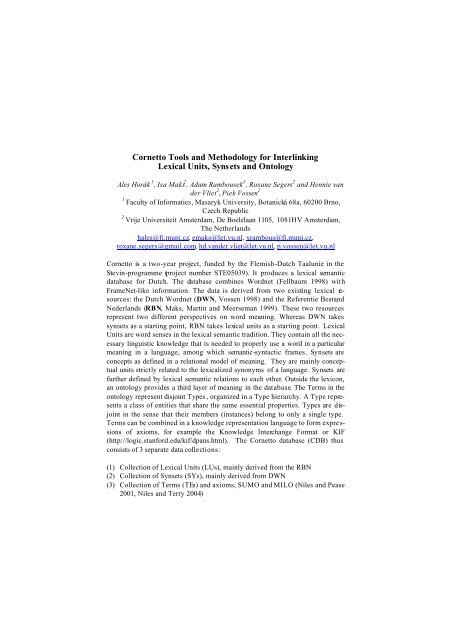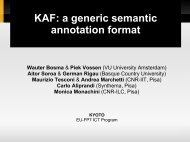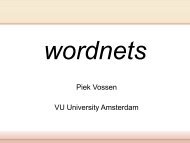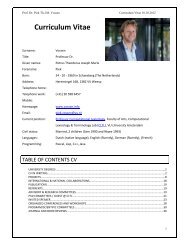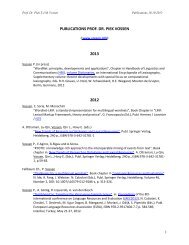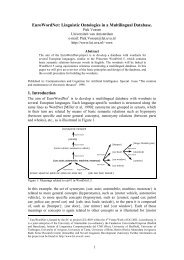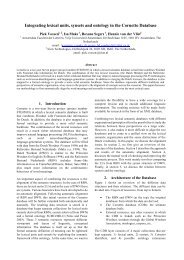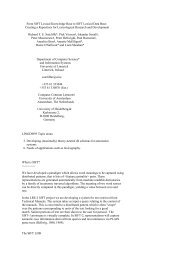Cornetto Tools and Methodology for Interlinking Lexical Units ...
Cornetto Tools and Methodology for Interlinking Lexical Units ...
Cornetto Tools and Methodology for Interlinking Lexical Units ...
You also want an ePaper? Increase the reach of your titles
YUMPU automatically turns print PDFs into web optimized ePapers that Google loves.
<strong>Cornetto</strong> <strong>Tools</strong> <strong>and</strong> <strong>Methodology</strong> <strong>for</strong> <strong>Interlinking</strong><br />
<strong>Lexical</strong> <strong>Units</strong>, Synsets <strong>and</strong> Ontology<br />
Ales Horák 1 , Isa Maks 2 , Adam Rambousek 1 , Roxane Segers 2 <strong>and</strong> Hennie van<br />
der Vliet 2 , Piek Vossen 2<br />
1<br />
Faculty of In<strong>for</strong>matics, Masaryk University, Botanická 68a, 60200 Brno,<br />
Czech Republic<br />
2<br />
Vrije Universiteit Amsterdam, De Boelelaan 1105, 1081HV Amsterdam,<br />
The Netherl<strong>and</strong>s<br />
hales@fi.muni.cz, emaks@let.vu.nl, xrambous@fi.muni.cz,<br />
roxane.segers@gmail.com, hd.v<strong>and</strong>er.vliet@let.vu.nl, p.vossen@let.vu.nl<br />
<strong>Cornetto</strong> is a two-year project, funded by the Flemish-Dutch Taalunie in the<br />
Stevin-programme (project number STE05039). It produces a lexical semantic<br />
database <strong>for</strong> Dutch. The database combines Wordnet (Fellbaum 1998) with<br />
FrameNet-like in<strong>for</strong>mation. The data is derived from two existing lexical resources:<br />
the Dutch Wordnet (DWN, Vossen 1998) <strong>and</strong> the Referentie Best<strong>and</strong><br />
Nederl<strong>and</strong>s (RBN, Maks, Martin <strong>and</strong> Meerseman 1999). These two resources<br />
represent two different perspectives on word meaning. Whereas DWN takes<br />
synsets as a starting point, RBN takes lexical units as a starting point. <strong>Lexical</strong><br />
<strong>Units</strong> are word senses in the lexical semantic tradition. They contain all the necessary<br />
linguistic knowledge that is needed to properly use a word in a particular<br />
meaning in a language, among which semantic-syntactic frames. Synsets are<br />
concepts as defined in a relational model of meaning. They are mainly conceptual<br />
units strictly related to the lexicalized synonyms of a language. Synsets are<br />
further defined by lexical semantic relations to each other. Outside the lexicon,<br />
an ontology provides a third layer of meaning in the database. The Terms in the<br />
ontology represent disjoint Types , organized in a Type hierarchy. A Type represents<br />
a class of entities that share the same essential properties. Types are disjoint<br />
in the sense that their members (instances) belong to only a single type.<br />
Terms can be combined in a knowledge representation language to <strong>for</strong>m expressions<br />
of axioms, <strong>for</strong> example the Knowledge Interchange Format or KIF<br />
(http://logic.stan<strong>for</strong>d.edu/kif/dpans.html). The <strong>Cornetto</strong> database (CDB) thus<br />
consists of 3 separate data collections:<br />
(1) Collection of <strong>Lexical</strong> <strong>Units</strong> (LUs), mainly derived from the RBN<br />
(2) Collection of Synsets (SYs), mainly derived from DWN<br />
(3) Collection of Terms (TEs) <strong>and</strong> axioms, SUMO <strong>and</strong> MILO (Niles <strong>and</strong> Pease<br />
2001, Niles <strong>and</strong> Terry 2004)
In <strong>Cornetto</strong>, the ontology represents an independent anchoring of the relational<br />
meaning in the Dutch wordnet. The ontology is a <strong>for</strong>mal framework that can be<br />
used to constraint <strong>and</strong> validate the implicit semantic statements of the lexical<br />
semantic structures, both the lexical units <strong>and</strong> the synsets. In addition, the ontology<br />
provides a mapping of a vocabulary to a <strong>for</strong>mal representation that can be<br />
used to develop semantic web applications. The differences in perspectives in<br />
these collections lead to different distinctions of concepts. For the relation between<br />
synsets <strong>and</strong> the ontology this can be illustrated with the example of water.<br />
In the English wordnet <strong>and</strong> SUMO, it is represented by two concepts: the<br />
chemical element H2O <strong>and</strong> bodies of water. In the Dutch wordnet there is an<br />
additional third meaning: water in its liquid <strong>for</strong>m (the most common appearance<br />
of water in our world). Furthermore, there are many hyponyms below this liquid<br />
concept that refer to the different usages of the substance in our daily life (in<br />
Dutch realized as compounds): theewater (water used <strong>for</strong> making tea), koffiewater<br />
(water used <strong>for</strong> making coffee), bluswater (water used <strong>for</strong> extinguishing<br />
fire). Whereas the chemical element is a disjunct type in SUMO, the other<br />
mean ings of water <strong>and</strong> their specific usages in the Dutch wordnet are not. In the<br />
<strong>Cornetto</strong> database, this can be expressed by a direct mapping of the noun water<br />
in Dutch to the element (being a straight name <strong>for</strong> the Type) <strong>and</strong> a complex contextual<br />
mapping of the other meanings to the same Type. The lexicalizations in<br />
Dutch thus do not grant the introduction if new Types in the ontology (Fellbaum<br />
<strong>and</strong> Vossen 2007.). Nouns <strong>for</strong> bodies of water are used to refer to instances of<br />
H2O occurring in certain quantities <strong>and</strong> locations. Nouns <strong>for</strong> usages are used to<br />
refer to quantities of the same H2O playing a temporarily role. These relations<br />
are expressed through simplified relational expression from the synsets to the<br />
ontology.<br />
The <strong>Cornetto</strong> database system allows you to define the relations <strong>and</strong> constraints<br />
between these different perspectives. It is a tool to study <strong>and</strong> encode these relations<br />
in a unique way. For storing <strong>and</strong> editing this complex database, we used<br />
the Dictionary Editor <strong>and</strong> Browser plat<strong>for</strong>m (Horá k, Pala, Rambousek <strong>and</strong><br />
Rychlý et al 2006). The Dictionary Editor <strong>and</strong> Browser (DEB) plat<strong>for</strong>m offers a<br />
development framework <strong>for</strong> any dictionary writing system application that needs<br />
to store the dictionary entries in the XML <strong>for</strong>mat structures. The most important<br />
pro perty of the system is the client-server nature of all DEB applications. This<br />
provides the ability of distributed authoring teams to work fluently on one common<br />
data source. The actual development of applications within the DEB plat<strong>for</strong>m<br />
can be divided into the server part (the server side functionality) <strong>and</strong> the<br />
client part (graphical interfaces with only basic functionality). The server part is
uilt from small parts, called servlets, which allow a modular composition of all<br />
services. The client applications communicate with servlets using the st<strong>and</strong>ard<br />
HTTP web protocol. We have developed four new modules. All the databases<br />
are linked together <strong>and</strong> also to external resources (Princeton English WordNet<br />
<strong>and</strong> SUMO ontology), thus every possible user action had to be very carefully<br />
analyzed <strong>and</strong> described. During the several months of active development <strong>and</strong><br />
extensive communication between Brno <strong>and</strong> Amsterdam, a lot of new features<br />
emerged in both server <strong>and</strong> client <strong>and</strong> many of these innovations we re also introduced<br />
into the DEBVisDic software. This way, each user of this WordNet<br />
editor benefits from <strong>Cornetto</strong> project.<br />
Acknowledgements<br />
The <strong>Cornetto</strong> project is funded by the Nederl<strong>and</strong>se Taalunie <strong>and</strong> STEVIN. This<br />
work has also partly been supported by the Ministry of Education of the Czech<br />
Republic within the Center of basic research LC536 <strong>and</strong> in the Czech National<br />
Research Programme II project 2C06009.<br />
References<br />
Chaudhri, A.B., A. Rashid, <strong>and</strong> R. Zicari (eds). 2002. XML Data Management:<br />
Native XML <strong>and</strong> XML-Enabled Database Systems. Addison Wesley<br />
Profes sional.<br />
Fellbaum, C. (ed). 1998. WordNet: An Electronic <strong>Lexical</strong> Database. Ca mbridge,<br />
MA: MIT Press.<br />
Fellbaum C. <strong>and</strong> P. Vossen. 2007. "Connecting the Universal to the Specific:<br />
Towards the Global Grid", In : Proceedings of The First International<br />
Workshop on Intercultural Collaboration (IWIC 2007), Kyoto, Japan,<br />
January 25-26, 2007<br />
Horák, A., K. Pala, A. Rambousek, <strong>and</strong> P. Rychlý. 2006. New clients <strong>for</strong> dictionary<br />
writing on the DEB plat<strong>for</strong>m. In DWS 2006: Proceedings of the<br />
Fourth International Workshop on Dictionary Writings Systems, pages<br />
17– 23, Italy, <strong>Lexical</strong> Computing Ltd., U.K.<br />
Maks, I., W. Martin, <strong>and</strong> H. de Meerseman. 1999. RBN Manual, Vrije Universiteit<br />
Amsterdam.<br />
Niles, I., <strong>and</strong> A. Pease. 2001. Towards a St<strong>and</strong>ard Upper Ontology. In: Proceedings<br />
of FOIS 2001, Ogunquit, Maine, pp. 2-9.<br />
Vossen, P. (ed). 1998. EuroWordNet: a multilingual database with lexical semantic<br />
networks <strong>for</strong> European Languages. Kluwer, Dordrecht.


